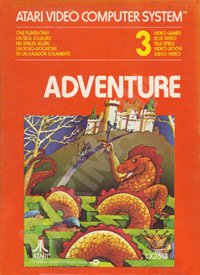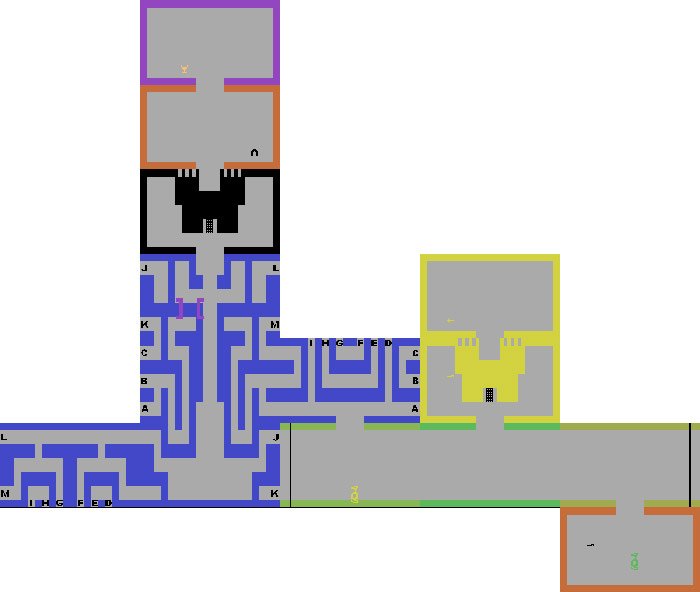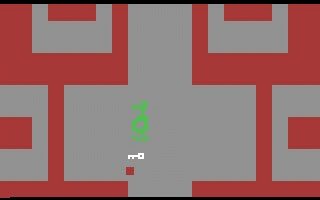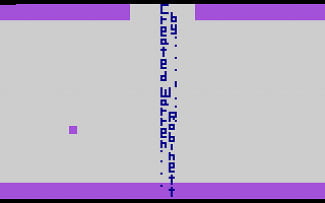A story of technical tricks and politics.
Thirty-five years after its release, the influence of the Atari 2600 classic Adventure can still be seen in hundreds of games every year.
The game’s reator, Warren Robinett, recently spoke at the Game Developers Conference about the challenges of creating the game, its inspiration, its impact, and that famous Easter Egg.
Embarking on an adventure
 The story begins in Sunnyvale, California in 1978. At Atari during this period game programmers and designers were one and the same.
The story begins in Sunnyvale, California in 1978. At Atari during this period game programmers and designers were one and the same.
“It was your job to think of an idea that could be implemented in the tiny, little memory available and then figure out a way to use the resources of the 2600 to make it a fun and interesting game,“ says Robinett.
The Atari 2600 hardware specifications were limited to 4k of ROM and 128 bytes of RAM. Robinett’s first game, Slot Racers, was a perfect example of how these limitations could be overcome to make a fun game. Indeed, Slot Racers still holds up as a diverting experience even today.
“Each 2600 game was created by one person. And it made sense back then,” recalled Robinett.
“You had the idea, you wrote the code, you created the graphics and the sound effects, you tested it on kids, and you de-bugged it and you decided when it was done.”
“But still, you could do a bigger game on it (the 2600). Combat had already been done on it. Larry Kaplan had done Air-Sea Battle. There were working examples, so when I started working there in the fall of ’77 there was no doubt that you could do it. But it was hard to use the weird little chip.”
The idea for Adventure was born when Robinett saw the game Colossal Cave Adventure. It was an early example of a text adventure. Robinett was impressed and considered how such a game could be adapted.
“This was 100% text,” he said. “It did have the idea of rooms and object and obstacles, all the elements that were in my game but no graphics, no animation, no sound. A different medium you might say.”
Robinett pitched the game to his boss at Atari, only to be told that it would be impossible to achieve.
“He knew that the text Adventure ran on a mainframe and it required 100k or more and the 2600 only had 2K or 4k. He told me it was impossible and not to work on it.”
Despite this instruction Robinett set about creating a proof-of-concept. This rudimentary, early version of the game took about a month to complete.
“It’s not the greatest keep-your-job strategy, but what I did was I just ignored my boss and worked on a prototype in secret,” he said.
“It’s best to be pretty sure it’s a good idea if you try an aggressive strategy like this but it’s also true that you have to fight for your ideas.”
Creating a game world
Eventually the concept was approved and Robinett got to work on the game. Development took about a year, during which he had to overcome many technical hurdles with the Atari 2600 and define how the game was to be represented with graphics, rather than text.
Robinett decided upon a map-like overhead view of the game-world, with the objects represented as icons and the player’s avatar as a simple square sprite.
“The reason it’s so simple is because the Atari 2600 only had two decent high resolution sprites, and it had three really low resolution sprites. They only had one pixel,” he said.

Another challenge was the method of replicating the Colossal Cave Adventure’s seven item inventory system.
“My solution was, you don’t!” said Robinett.
As a result the player could only carry one object at a time.
“I like the idea of staying real-time, so I didn’t want an inventory screen. Finally I decided to limit it to one object.” he remembered.
The decision had a number of benefits, in addition to reducing the complexity of the game’s code.
“It gave you strategic choice. Do you carry the weapon or the treasure?” said Robinett.
“And it simplified the user interface, because carrying only one object I could run into it to pick it up, and use the button on the joystick to drop it. For this situation it worked well.”
The game’s impressive sense of AI was achieved using model of fear and desire. Each object was given a particular attribute that caused it to react to other objects in a specific way.
“I thought of it as behaviourism. I came up with a pretty simple way to define what I called a chase/flee list, which was a set of rules.”
There were only two responses; one was to chase an object and the other was to run away from an object.
“In this case I had a simplified, abstract version of what stimulus and response meant. I thought of chasing as meaning that object was desired and running away from it meant that object was feared.”
For example, the yellow dragon would chase the man or chalice but flee from the key or sword. By setting up these relationships the game appeared remarkably free-form.
“Why did I put the bat in there you might ask? I added the bat to keep the game from being too predictable. Its job is to move objects around,” said Robinett.
“People liked playing it, but once you had beaten level 1 and beaten level 2 there wasn’t much interest left. You were just repeating the same things.”
The bat ensured that the game changed with each play-through.

“To make the game more interesting I also added a third level to it in which the objects would be randomly placed in the game-world. But after that random placement at the beginning there was no more randomness. Every object was somewhere in the game world and it moved around according to its own rules. Objects were never created or destroyed in Adventure. They were always somewhere in the game world.”
Robinett likens this approach to random element of card games.
“I thought of it like the deal at the start of a hand of Bridge. Bridge would be boring if you didn’t have a random deal.“
Efficient coding
Adventure created the rule book for what became the action adventure genre. This is impressive in itself but even more so when the limitations of the Atari 2600 are considered. Robinett is clear about his method for overcoming these limitations.
“The short answer is a good data structure and efficient coding,” he said.
“The game contain 30 rooms, 14 objects, 4 creatures. It fit into 4k at 128 bytes. I was pleased that I was able to solve all the puzzles and fit it into the resources available.“
Robinett believes that his background in computer science helped him achieve this feat. Unlike many other Atari developers he didn’t have to ‘crunch’ the code in order to recover stray bytes to use.
“I had studied Computer Science, and then I got a masters degree at Berkeley,” he said.
“I was pretty well trained and I was lucky enough to be at Berkeley when Ken Thomson, the co-inventor of Unix and C, was there for one year as a visiting professor. I took a course from him, called Operating Systems and he required us to use C. I was lucky enough to have learned C just two years before I worked at Atari and I believe that it taught me to think like a C programmer. You could write an Assembly language program and think like a C programmer.”
Atari politics
Adventure was a huge success upon release. However, due to the terms of employment at Atari, Robinett received nothing in the way of royalties. Atari programmers were a utility, not a creative force.
“It sold about a million units at $25 each, I got paid a salary of $22,000 a year and no royalty,” he recalled.
“But I think of it as a David and Goliath story, as the big-money men from New York didn’t succeed in controlling us 2600 programmers very well. They treated us so badly that everybody quit and started competing companies.”
In a bold display of rebellion Robinett did manage to receive a credit within the game. Hidden by his own hand there is a secret room containing the words:
“Created by Warren Robinett.”
Robinett told no-one about the credit. And once the game had been shipped, it was too late for it to be removed. It’s widely acknowledged as being one of the first “Easter Eggs” but Robinett has a more personal view.
“I didn’t call it an Easter Egg. I called it my signature.”

Adventure set a template for action adventure games that has held true for over three decades. Its influence can still be found in Skyrim, Zelda and Dark Souls to name a few.
For a game so tiny, it’s no small achievement.
–
Warren Robinett is publishing an ebook about the creation of Adventure later this year. You can find out more here: http://www.warrenrobinett.com/adventure
Lead image credit: Official GDC






